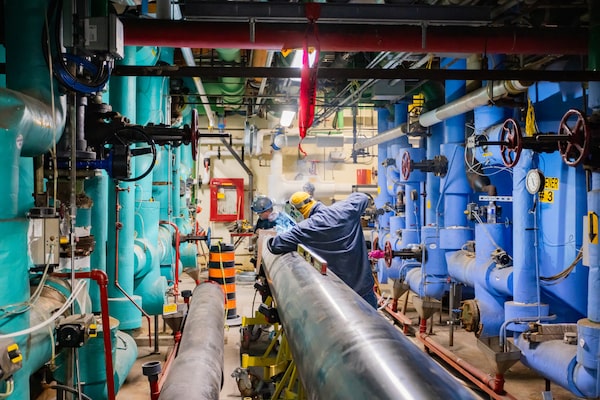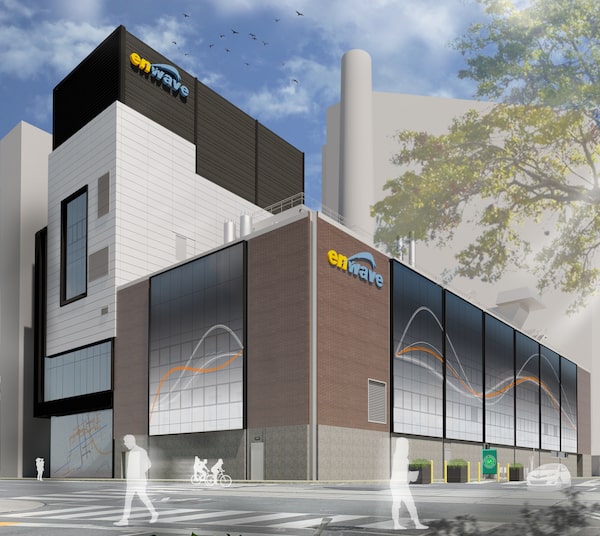
Toronto-based Enwave Energy Corp., which owns and operates the giant deep lake water cooling (DLWC) system, is expanding its 40 kilometres of underground water pipes.Enwave Energy Corp.
Toronto is digging deep to expand what experts already consider to be one of the coolest and most environmentally friendly energy projects on Earth – the city’s deep lake water cooling system.
Toronto’s Enwave Energy Corp., which owns and operates the giant deep lake water cooling (DLWC) system, already has some 40 kilometres of underground water pipes that snake through Toronto’s downtown and extend about five kilometres into Lake Ontario. The lake pipes channel water to and from a downtown heat transfer station at Pearl Street (west of University Avenue, between Adelaide Street West and King Street West).
At a time when cities, government agencies and many private-sector firms are struggling to build or boost infrastructure projects, Enwave is now expanding the Pearl Street station as part of a $100-million program to increase the system’s reach to even more Toronto buildings. Enwave is co-owned by Ontario Teachers’ Pension Plan and IFM Investors, a group of Australian pension funds.
“The expanded system is expected to be commissioned by the end of this year. We’re increasing our capacity by 40 per cent,” says Carlyle Coutinho, Enwave’s president. The company received funding for the Pearl Street upgrade and additional clean-energy projects from the federal government’s Low Carbon Economy Fund and the Canada Infrastructure Bank.
Toronto’s DLWC – the world’s largest system of its kind – currently serves 180 buildings covering more than 40 million square feet of downtown real estate, including venerable landmarks such as the Toronto-Dominion Centre, Brookfield Place, Scotiabank Arena, eight hospitals and, most recently, the Fairmont Royal York hotel.
“The Pearl Street project is a facility we call Enwave Green Heat that will provide enough low-carbon heating to make it possible to have an additional 10 million square feet of commercial towers in downtown Toronto net-zero heated,” Mr. Coutinho says. (That’s roughly the same size as 170 football fields.) Enwave is also adding a fourth intake pipe deep in Lake Ontario that will run alongside the three existing intakes.
DLWC technology is surprisingly simple, drawing water from Lake Ontario at a depth of 85 metres, where the water temperature is 4 C. The water goes through Toronto’s Island filtration plant where it is treated for use as drinking water.
The expanded system is expected to be commissioned by the end of this year. We’re increasing our capacity by 40 per cent.
— Carlyle Coutinho, president of Enwave Energy Corp.
From there, water is pumped toward the city, where it circulates through a network of 40 kilometres of downtown pipes that make their way through the interiors of different buildings hooked up to the system.
The Pearl Street facility is a major stop along the way for the water. It is more or less a giant version of the heat exchangers that people install in their homes to lower their energy bills.
The cold water that circulates through the downtown network whisks its way through the buildings and is looped through Pearl Street and additional Enwave facilities where there are heat exchangers.
The exchangers transfer heat and cold between adjacent pipes. Depending on the season and the needs of buildings, their occupants and the rest of the city, water in adjacent loops can either be warmed electrically for hot water and heat or left just warm enough to be returned to municipal drinking supplies.
Water that’s drawn from Lake Ontario and not used for drinking water is returned to the lake at roughly the same temperature it was when it left.
Although many environmentalists say they like DLWC, there is some concern that its reliance on electricity for pumping and running the giant heat exchangers could contribute to carbon emissions if the power is from coal- or gas-fired plants or pose other risks if the source is nuclear energy.

The expanded system, which will increase capacity by 40 per cent, is expected to be commissioned by the end of this year.Enwave Energy Corp.
Tim Gray, executive director of the not-for-profit group Environmental Defence, says DLWC is “smart and effective.”
“The water used to carry out this work has to be pumped anyway as it is part of our drinking water supply, and the electricity used is much less than the energy that would be required to air condition or heat otherwise,” he explains.
“In Ontario, it comes from a grid that is low on fossil fuels, though, in the future, it could be even greener If Ontario invested in more renewable energy,” he says.
The DLWC system was launched in 2004 but has been picking up steam since Canada set the goal of becoming, by 2050, net zero in carbon emissions that cause climate change. As the system expands to more and more buildings, owners and operators are finding new and different ways to join in.
For example, Enwave partnered with developers of the Well, a mixed-use development with more than three million square feet of retail, office and residential space, to install a thermal storage facility underneath the project. It consists of a large temperature-controlled tank fed by the DLWC system, with the capacity to hold 7.6 million litres of water.
The storage facility serves as a thermal “battery,” storing energy at night during off-peak times, easing strain on the electricity grid and reducing costs. This storage can supply low-carbon heating and cooling to an additional 17 million square feet of space.
Some owners and developers have discovered that joining the system can be easier than they first thought. “When we were looking at our energy retrofit, we discovered that decades ago, the deep lake system was already built right up to one side of the foundation of the Royal York,” says Steven Gross, vice-president of asset management, multiresidential and hotels at KingSett Capital, which owns the building.
The hotel’s energy retrofit, which included integrating DLWC, achieved the Canada Green Building Council’s Zero Carbon Building – Performance Standard certification late last year.
“We were delighted. We also wondered: Why had nobody noticed this before?” Mr. Gross says.
Mr. Coutinho wonders why the entire DLWC system doesn’t get more worldwide attention.
“We’re the biggest commercial deep lake company in the world and we’re one of the biggest commercial district energy companies in North America,” he says.